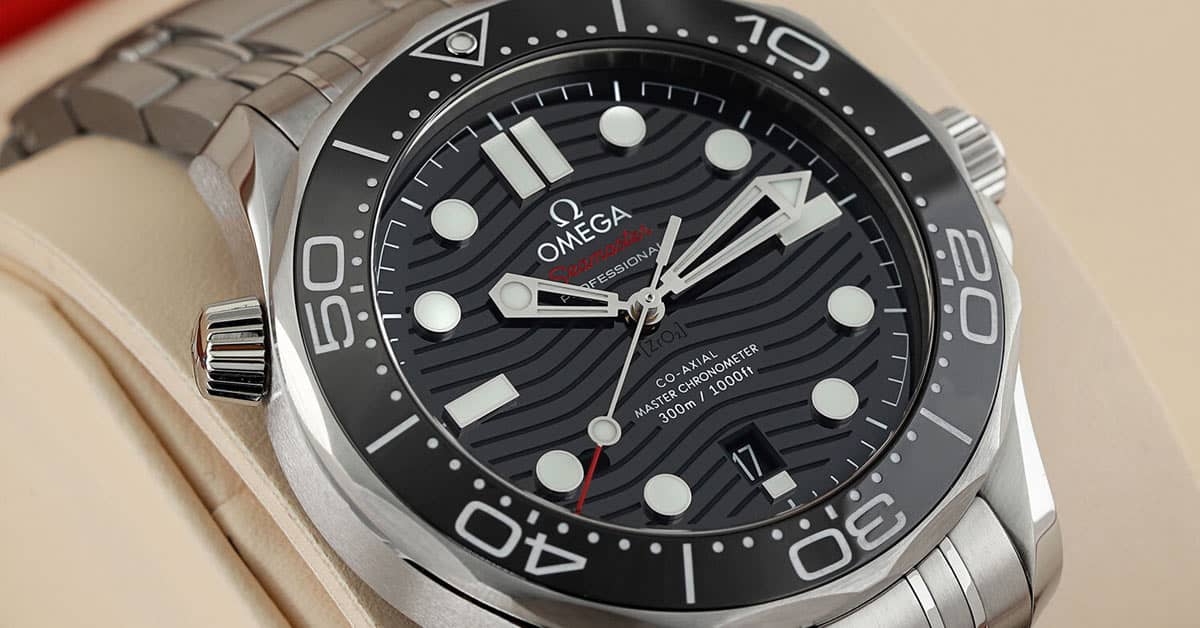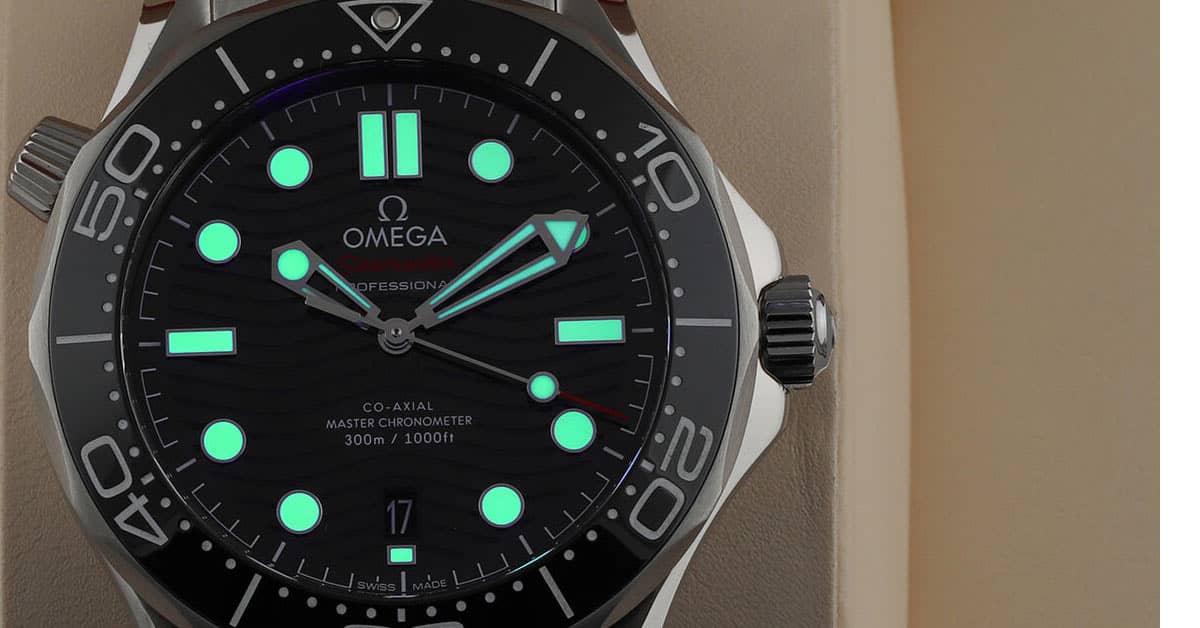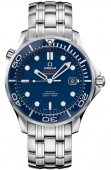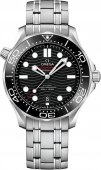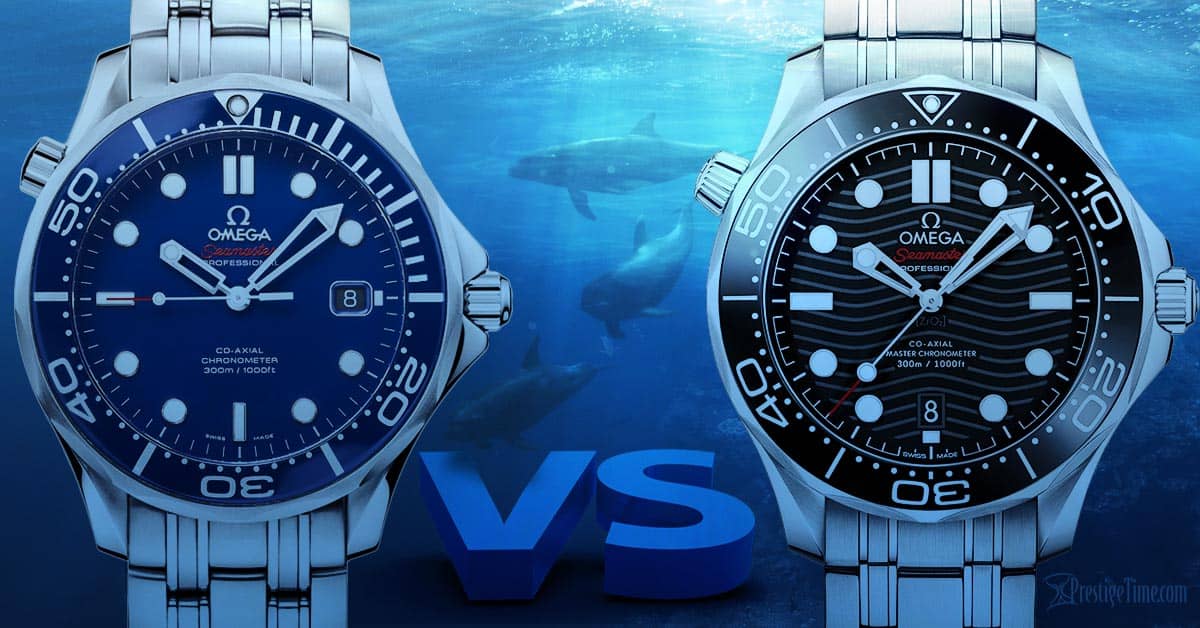
New Omega Seamaster Diver 300m Co-Axial Master Chronometer Review
Let’s compare the Omega Seamaster Diver 300m Co-Axial to the newer 2018 25th Anniversary edition of the Omega Seamaster Diver 300m Co-Axial Master Chronometer and see what has been improved.
What are the differences between the new Omega Seamaster Diver 300m Co-Axial MASTER CHRONOMETER and the previous versions which do not have the Master Chronometer designation?
For starters, this one has a transparent case back that lets you see the movement. Something that enthusiasts and collectors absolutely love.
On the outside, you can see the hot new wavy pattern on the dial reminiscent of the Seamaster watch featured in a 1995 James Bond film titled ‘Goldeneye’. Let’s not forget to mention a slightly larger case size of 42mm compared to the previous 41mm Seamaster.
Just by holding both in my hand, I can tell you that they pretty much weigh the same. In terms of looks, there are some similarities but some striking differences between these two watches as well.
Let’s look at some of the things that make this new 2018 Seamaster 300m different from its predecessor.
Let’s Begin with the Bezel:
- The bezel is newly designed with a slimmer profile which to some isn’t as easy to grip but to make up for it, the bezel has much smoother action that takes much less effort to rotate and doesn’t make nearly as loud of a clicking sound when rotated.
- The bezel is made of a highly scratch-resistant ceramic that won’t color fade when exposed to UV rays the way non-ceramic bezels do. This bezel could look just as good 20 years from now as it does today.
- The bezel’s numerals and track are in white enamel, a durable material allowing it to stay a bright white for longer.
- The Triangle at the “start mark” of the bezel is now outlined in a white enamel instead of a laser engraved as a solid triangle solid as on the previous model.
- The luminous dot in the center of this outlined triangle is slightly smaller than before and the numerals on the bezel are slightly larger. Since they are in bright white enamel, they are now more visible in low light conditions.
Let’s Compare the Case with the previous Seamaster 300m:
- The case size is slightly larger at 42mm; this is only a 1mm increase from the previous version. This is of course measured without taking the crown, crown guards, or helium escape valve into consideration.
- At 13.7mm thick the new Seamaster 210 model is thicker by less than 1mm than the 212 that came before it
- The helium escape valve is completely redesigned. It protrudes further than the previous model making it easier to grip and to the newly designed Helium escape valve is flared at the end to make look the same size as the older model. It’s probably worth noting that according to Jean-Claude Monachon, the Head of Product Development and VP at Omega, this new helium escape valve was engineered and tested for 300m water resistance while in both the closed and opened position.
- The case back in no longer flared like the earlier Seamaster 300m and is now flat giving the profile of the case a less pebble-like shape.
- The case back is one of the most exciting new features. Yes, we finally have a trusty go-to Seamaster with a transparent sapphire case back.
Time to Discuss to the Dial
- The once glossy classic dial of the Seamaster 300m which was seen from 2012 – 2017, is now history and it was replaced with an engraved wavy pattern that provides more texture and depth to the design. This wave pattern was typically seen on the Seamasters from 1993-2011 You might look at it and think of the older Seamaster model # 2531 or even the Seamaster 2541 used on the James Bond movie called “Goldeneye” featuring Pierce Brosnan.
- The date window was moved from 3 o’clock to the 9 o’clock position and as a result, the six o’clock hour marker has been shortened and the 3 o’clock hour marker is now the same length as the 9 ‘o’clock hour marker now making the design of the dial perfectly symmetrical. Another practical change to the date window is that the numerals are now in a bright white color and therefore more legible than the chrome finish of the older model.
- The minute track has a new segmented semi-railroad design that is split up into 5-second intervals.
- The blue luminescent material is used for the index and dot hour markers, and the tip of the hour hand and a second green luminescent color is used for the bezel dot and the tip of the minute hand.
- ZrO2 engraved in the center of the dial indicates that it is a Zirconium Dioxide ceramic dial.
There are many new design variations and an improved helium escape valve, crown, and crown guards design but that’s not what you’re here for, is it? Let’s pop that hood and talk about what’s going on inside the watch! Shall we? By the way, if you haven't had a peek at it yet click on the video button below.
To first understand the differences between the Omega Master Co-Axial caliber 8800 automatic movement that powers this new series, we should look at the self-winding movement that powered its predecessor, the Omega Caliber 2500 d. The previous Seamaster's movement had brought innovation to the Omega Seamaster 300m collection. This was the introduction of Omega’s patented Co-Axial escapement. Thankfully, it is also a highlighted feature in the new 2018 model.
What makes the Master Chronometer different from a COSC Certified Chronometer?
The latest feature to embrace the Seamaster Diver 300m family is the coveted Master Chronometer designation. What exactly does this mean for your Seamaster watch? For starters: very high precision and excellent resistance to the enemy #1 of all mechanical watches; electromagnetic frequencies (EMF).
Using the button below, see how the Master Chronometer revolutionized Omega watches.
You have most likely seen the designation of a Chronometer on various luxury watches before. This designation originated for marine navigators to know that their watches meet the required precision to navigate the vast oceans timing their maneuvers to perfection.
Obviously, this was well before the GPS was ever invented but to sum it up in a nutshell, a 3rd party official Swiss chronometry lab called COSC tests the movement and if it passes all their requirements, COSC issues what’s called a ‘COSC certificate’. Once the watch movement receives this certificate it can thereafter be called a COSC certified Chronometer. To pass all the testing the watch movement must show a minimum accuracy of -4/+6 seconds per day.
The COSC Chronometer designation was at one point the highest designation that an analog watch can get. The Master Chronometer, on the other hand, took the testing several steps further. Not only does Omega send all their movements (also known as calibers) to the COSC facility for testing, but once they receive the COSC certificate they send it to another 3rd party lab known as METAS (a Swiss Metrology lab). This second lab not only tests to achieve even higher accuracy than a COSC Chronometer but perform all sorts of other tests. See the list below.
Tests performed by METAS:
- METAS tests the movement for its resistance to electromagnetic interference and exposes the watch to magnetic fields with a magnetic flux density of up to 15,000 gauss or 1.5 Tesla while in 2 different positions.
- Then they place the caliber in the watch case and test it all over again for magnetic fields of 15,000 gauss.
- Then they expose the watch for a full 24 hours to the same intensity of electromagnetism and through daily testing ensure that the daily deviation in precision is within specs of their target.
- They then test the watch for 96 hours to assure it stays accurate while changing the positions of the watch and expose it to environmental and temperature fluctuations.
- Then they test the Power Reserve of the watch and make sure that it meets what is advertised.
- Then they place the watch in 6 different positions while testing it for any deviation of accuracy which can occur when a watch is placed at certain angles which creates extra drag on the caliber.
- Then they test for any deviations while the power reserve is between one 3rd wound and a fully wound.
- Last but not least they test the water-resistance to ensure that it meets the advertised amount.
Once all this METAS testing is complete, the watch now has two pedigrees; one is the Chronometer designation from COSC, the other designation is from METAS and is called a MASTER CHRONOMETER. As you can see Omega is taking their job very seriously.
Their mission is clearly to provide diving professionals with the best diving watch in 2018. These improvements to the Seamaster certainly puts them ahead of the curve. Omega has also now applied the Master Chronometer designation to the Seamaster Chronographs. Things just get better and better!
To show special discounted pricing click on the button below.
